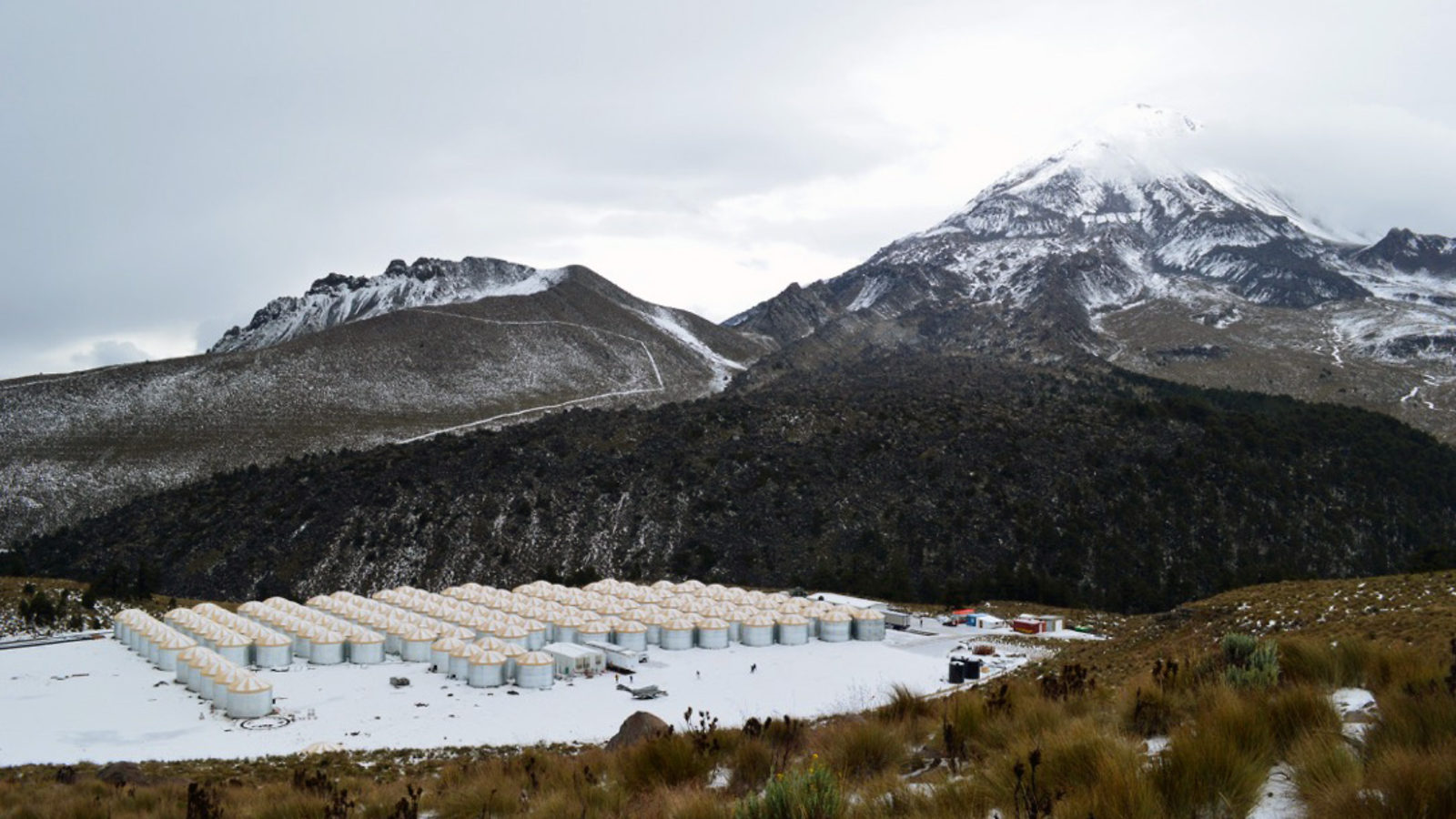On Thursday, atop Volcán Sierra Negra, on a flat ledge near the highest point in Mexico, technicians filled the last of a collection of 300 cylindrical vats containing millions of gallons of ultrapure water.
Together, the vats serve as the High-Altitude Water Cherenkov (HAWC) Gamma-Ray Observatory, a vast particle detector covering an area larger than 5 acres. Scientists are using it to catch signs of some of the highest-energy astroparticles to reach the Earth.
The vats sit at an altitude of 4100 meters (13,500 feet) on a rocky site within view of the nearby Large Millimeter Telescope Alfonso Serrano. The area remained undeveloped until construction of the LMT, which began in 1997, brought with it the first access road, along with electricity and data lines.
Temperatures at the top of the mountain are usually just cool enough for snow year-round, even though the atmosphere at the bottom of the mountain is warm enough to host palm trees and agave.
“The local atmosphere is part of the detector,” says Alberto Carramiñana, general director of INAOE, the National Institute of Astrophysics, Optics and Electronics.
Scientists at HAWC are working to understand high-energy particles that come from space. High-energy gamma rays come from extreme environments such as supernova explosions, active galactic nuclei and gamma-ray bursts. They’re also associated with high-energy cosmic rays, the origins of which are still unknown.
When incoming gamma rays and cosmic rays from space interact with Earth’s atmosphere, they produce a cascade of particles that shower the Earth. When these high-energy secondary particles reach the vats, they shoot through the water inside faster than particles of light can, producing an optical shock wave called “Cherenkov radiation.” The boom looks like a glowing blue, violet or ultraviolet cone.
The Pierre Auger Cosmic Ray Observatory in western Argentina, in operation since 2004, uses similar surface detector tanks to catch cosmic rays, but its focus is particles at higher energies—up to millions of giga-electronvolts. HAWC observes widely and deeply between the energy range of 100 giga-electronvolts and 100,000 giga-electronvolts.
“HAWC is a unique water Cherenkov observatory, with no actual peer in the world,” Carramiñana says.
Results from HAWC will complement the Fermi Gamma-ray Space Telescope, which observes at lower energy levels, as well as dozens of other tools across the electromagnetic spectrum.
The vats at HAWC are made of corrugated steel, and each one holds a sealed, opaque bladder containing 50,000 gallons of liquid, according to Manuel Odilón de Rosas Sandoval, HAWC tank assembly coordinator. Each tank is 4 meters (13 feet) high and 7.3 meters (24 feet) in diameter and includes four light-reading photomultiplier tubes to detect the Cherenkov radiation.
From its perch, HAWC sees the high-energy spectrum, in which particles have more energy in their motion than in their mass. The device is open to particles from about 15 percent of the sky at a time and, as the Earth rotates, is exposed to about 2/3 of the sky per day.
Combining data from the 1200 sensors, astrophysicists can piece together the precise origins of the particle shower. With tens of thousands of events hitting the vats every second, around a terabyte of data will arrive per day. The device will record half a trillion events per year.
The observatory, which was proposed in 2006 and began construction in 2012, is scheduled to operate for 10 years. “I look forward to the operational lifetime of HAWC,” Carramiñana says. “We are not sure what we will find.”
More than 100 researchers from 30 partner organizations in Mexico and the United States collaborate on HAWC, with two additional associated scientists in Poland and Costa Rica. Prominent American partners include the University of Maryland, NASA’s Goddard Space Flight Center and Los Alamos National Laboratory. Funding comes from the Department of Energy, the National Science Foundation and Mexico’s National Council of Science and Technology.



